What It Was Like To Eat At The First Big Boy Restaurant

Eating at the first Big Boy restaurant back in the 1930s would have been an amazing experience. Yes, the food was delicious and the service fantastic, but more importantly, there was a cultural revolution happening there. This chain and its owner changed popular culture and perhaps helped make fast food more widespread. Big Boy has a strong connection to a famous Hollywood animator. It also has ties to at least one renown comic book author. Some say this company had a role in shaping 1950s architecture. Finally, a fundamental item on fast food menus today might not exist if it hadn't been for this chain. Big Boy set the tone for a generation, but it has faded into relative obscurity because it was very much a product of a certain era. How can a chain, known best as a drive-in, continue to exist when this style of eating out has become nearly extinct?
Allow your imagination to journey back in time. Take a bite from a burger, and use a spoon to dip into an ultra-thick shake. To better understand what it was like to dine at the first Big Boy restaurant in California, the Glendale Historical Society and the Glendale Library's history room shared old photos from their collections. Then, a friendly couple, Bob and Laura Lynn LoFiego, recounted what it was like to be a regular at the Bob's Big Boy in Van Nuys, California, in the 1960s. Join us as we stroll down memory lane.
Read more: Fast Food Hamburgers Ranked Worst To Best
Big Boy Started In Glendale, California
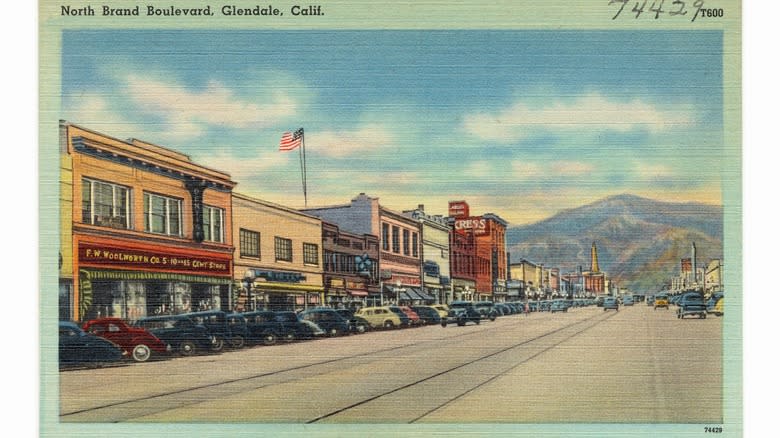
You had to be in Glendale, California, to eat at the first Big Boy. The year was 1936, and you might have been traveling through town on one of the four major highways. A twinge in your stomach had you looking for the nearest burger stand. These cheap eateries were sprouting like California poppies in the southern part of the state. Urban planning was accommodating a larger number of automobiles, making small restaurants with big parking lots a viable business. Finally, you saw what you were looking for and pulled your brand new Ford Lincoln-Zephyr over on Colorado Street to park outside a cozy, 10-seat hamburger stand.
You would have been entertained by a bustling scene through the window as you bit into your burger. In the '30s, Glendale was one of the country's fastest growing cities, with about 60,000 citizens. Today, it is home to nearly 190,000 people and Dreamworks Animation. Glendale is just about a half-hour drive from the razzle and dazzle of Hollywood and the high-end shops of downtown Los Angeles. Back then, it couldn't have seemed farther away from the glamour of showbiz with its newly constructed Spanish-style suburban neighborhoods.
Bob Wian Was The Owner Of Bob's Big Boy
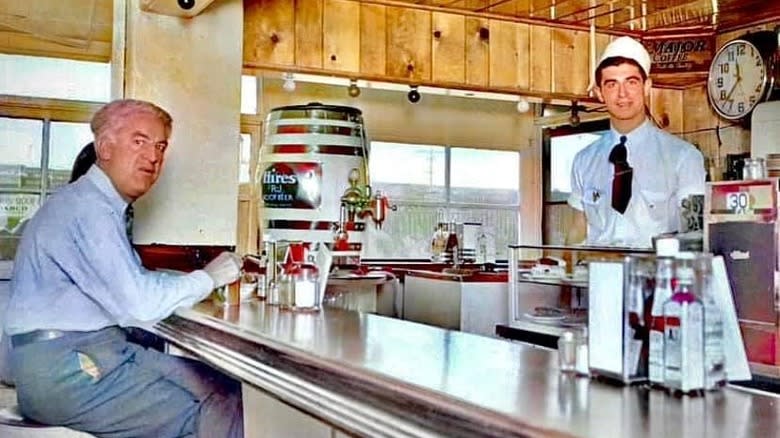
Bob Wian would have taken your order at that first Big Boy. He'd tell you he wasn't a Glendale native — his family had moved there in the late '20s when Wian was a teenager. While you finished your milkshake, he might chat more and explain that his first years in town had been bumpy. His high school classmates had even voted him the least likely to succeed. He initially found his bearings working as a short-order cook. Within a few years the young entrepreneur got the funds to open his own history-making hamburger stand when he sold his DeSoto Roadster. He wanted his restaurant to feel clean and respectable, so he ground the meat for burgers where customers could watch. The cooks and waitresses followed a code of conduct. In an interview on Bob's Big Boy YouTube channel, Wian said, "In the old days ... the cooks were wino and the waitresses were a ready date, and I tried to put some dignity into it."
The restaurateur is also often credited with inventing the California coffee shop. This term, nearly synonymous with a 1950s diner, describes a restaurant with geometrical architecture, neon signs, large car parks, and 24-hour-a-day service. Wian didn't achieve this at his first location, though, which was a 1930s greasy spoon through and through. The California coffee shop was born later when he expanded to Burbank, about a 10-minute drive from his first location.
You Might Have Seen Richard Woodruff Cleaning Up
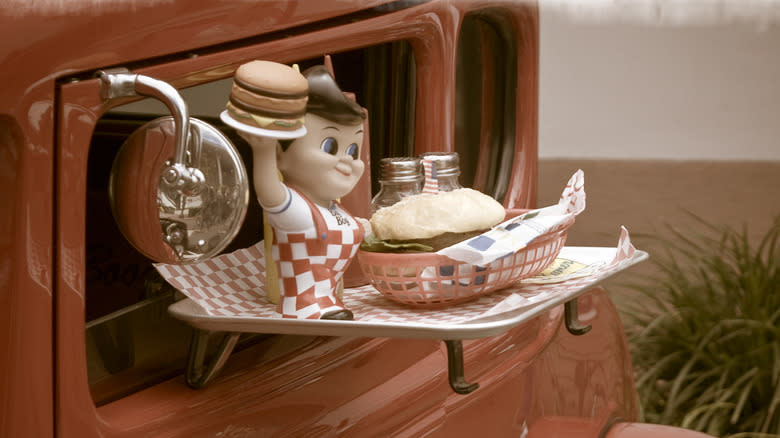
A chubby 6-year-old might have interrupted your lunchtime chat with Bob Wian in those early days of the restaurant. He'd come tumbling through the door, begging for a free hamburger. Wian would just smile and hand the kid a broom or a cloth to wipe down counters. He'd have him work for his free sandwich. The tubby little figure in overalls, earning his lunch, became a routine sight for the residents of Glendale, and most of the regulars at Bob's restaurant knew him.
The little boy's name was Richard Woodruff, and he'd later become the inspiration for the chain's mascot. He visited the restaurant so often because he loved the burgers there. Nearly 50 years later, his obituary would appear in The New York Times. The summary of his life referred to him as a Glendale celebrity and said his appearance and droopy overalls had inspired the statues that adorned Big Boy restaurants across the country.
[Featured image by Damian Gadal via Wikimedia Commons | Cropped and scaled | CC BY 2.0 DEED]
Big Boy Wasn't The Restaurant's Original Name
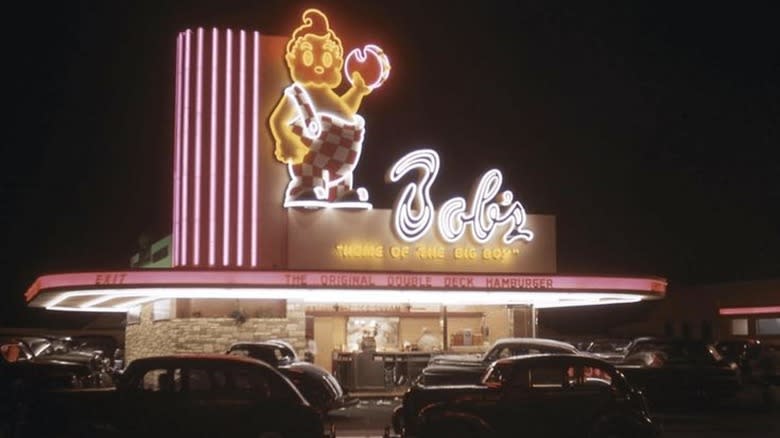
Today, you know the restaurant as Big Boy or perhaps Frisch's Big Boy. If you ate there in the 1980s, you might have called it Elias Brothers, Shoney's, or Marc's Big Boy, depending on where you lived. In 1936, though, the sign above the burger stand simply read Bob's Pantry. Then, one day, owner Bob Wian greeted his youngest regular, 6-year-old Richard Woodruff, saying something like, "Hey there, Big Boy!" The nickname stuck for both the kid and the restaurant. In 1938, the place became Bob's Big Boy and switched to a drive-in restaurant.
When Wian later started selling franchises, he determined owners should add their own name to the restaurant and have freedom over their menus. This resulted in nearly three dozen different names for Big Boys at the height of the company's success. This made it hard to advertise nationally, though, and ultimately it was one of the reasons the chain was less successful than some of its competition. Today, the remaining Big Boy locations have dropped the owners' names -- about 84% of them are in Michigan. Just four Big Boys remain in California, the chain's birthplace. Frisch's Big Boy, on the other hand, has long been a separate company, its owner having bought the rights to the name and the double-deck hamburger from Wian in the 1940s. Today this chain with a shared history to the original restaurant has nearly 80 locations in Ohio, Indiana, and Kentucky.
It Was The Great Depression
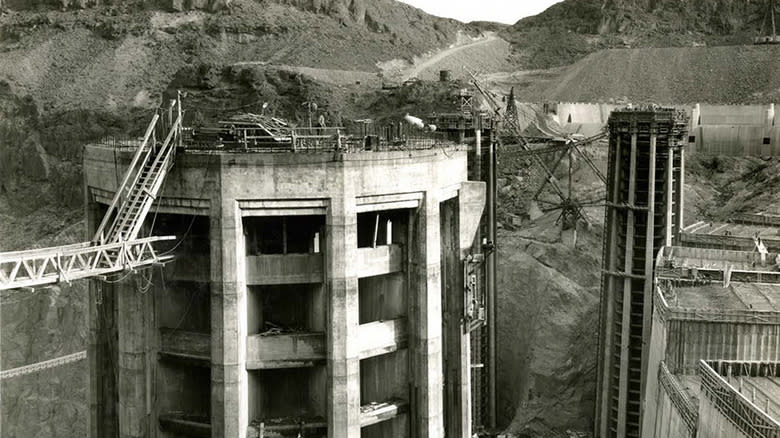
Bob Wian started his restaurant during the Great Depression. California, like the rest of the U.S., suffered from high unemployment rates, and workers received low wages. Thousands of desperate families had flooded the Golden State to escape the Dust Bowl. That put more pressure on the failing economy. It might have seemed like the wrong time to start a business, but a few factors contributed to the success of Big Boy.
First, Bob's lunch counter specialized in cheap hamburgers. These sandwiches were rising in popularity in the '30s, but many older people at that time had never heard of them. Diners usually felt distrustful of ground beef, wrongly thinking every part of the animal went into the grinder. Perhaps the low price of Bob's burgers and the visibility of his kitchen drew customers in when other dining establishments were hard-pressed for business. His willingness to trade meals for services from regulars like Richard Woodruff and cartoonist Bennie Washam also made his stand attractive.
By the late 1930s, Los Angeles and the surrounding area were recovering more quickly than other parts of the country. Construction of the Hoover Dam at Lake Mead was completed in 1936 -- the same year Wian opened his burger stand. The cheap, easily available electricity from the dam was an economic boon to the region, and Hollywood was booming again. The extra cash in people's pockets meant they had a little more to spend at Bob's.
Your Kids Could Get A Big Boy Comic Book
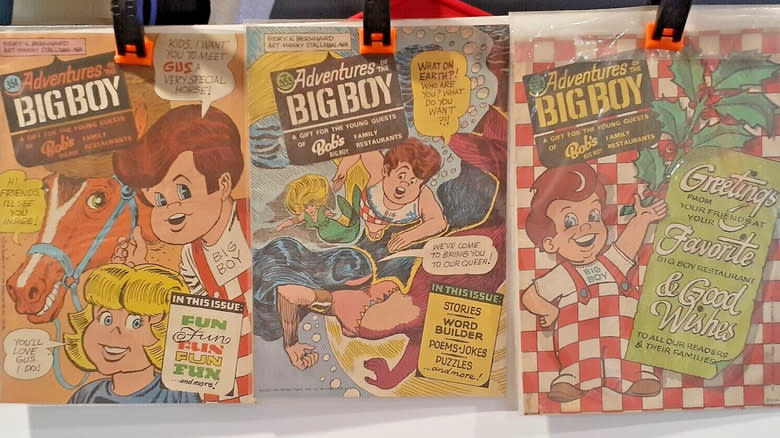
While eating your lunch at the first Big Boy, you might also have noticed an artist scribbling away on napkins. Cartoonist Benny Washam -- best known for his work on Bugs Bunny and Tom and Jerry at Warner Bros. -- ate at Bob Wian's restaurant. On one occasion, he traded a caricature of a boy named Richard Woodruff in overalls for a free hamburger. That piece of Washam's work would go on to become one of his most famous, though for many years he was not credited for his work nor would he receive additional payment for it.
Washam's caricature became more than just Big Boy's mascot and the inspiration for the statues outside the restaurants. This drawing of a cute, chubby 6-year-old went on to appear in a series of free comic books, given away to Big Boy customers between 1956-1996. For the first years, Timely Comics, Marvel's predecessor, produced them. The writer of Big Boy comics during those early years? Stan Lee, who went on to create many of Marvel's iconic superheroes.
Double-Deck Hamburgers Were On The Menu

Big Boy had the double-deck hamburger on its menu decades before McDonald's Big Mac, Burger King's Whopper, and Wendy's Double Stack were even on the drawing board. Bob Wian is credited with inventing double-stack cheeseburgers with a bun-burger-bun-burger-bun format in 1937. The official story says a customer was asking for something new and different. Wian sliced the bun into three parts and added two burgers. The Big Boy burger became a permanent fixture on the menu. Ordering one with a milkshake would have cost you $.30 in those early days. Adjusted for inflation using Nerd Wallet's calculator, that would comes out to just under $7 today.
Bob LoFiego remembers that his wife, Laura Lynn LoFiego, loved the double cheeseburgers at the Big Boy restaurant in Van Nuys in the '60s, "She was pregnant and craved cheeseburgers," he recalled. If the line was too long at Big Boy, the couple would cross the street to McDonald's where the burgers were cheaper but not as good, he said.
Bob's double burgers made restaurateurs want to join the franchise. The recipe for this star menu item depended on the restaurant, though. Wian added lettuce, cheese, a special red relish, and mayonnaise, and that's what you would have eaten in Glendale, Burbank, or Van Nuys. Other restaurants in the system added a special Big Boy sauce. Meanwhile, Frisch's cooks added dill pickles and tartar sauce instead. People loved every version, and none would exist without Wian.
Big Boy Was A Drive-In

Bob's Pantry started out as a 10-seat burger stand, but it quickly became a drive-in. Carhops carried orders to customers parked outside. This was a unique cultural moment -- the automotive crowd meets the culinary set. People dined in their cars to see and be seen. Some historians even say car design imitated the sweeping roofs of California coffee shops -- think triangle-shaped fins on the backs of cars from the late '50s. Others say both designs copied the lines of fighter jets from World War II.
Bob LoFiego frequented the Van Nuys location in the '50 and '60s because it was the only fast food around. He tells Mashed, "There would be lines of cars up and down Van Nuys Boulevard going through the Big Boy." Rodney Herrick told the Los Angeles Times in the 1980s he associated Glendale's Big Boy with the car he drove when he was younger. He reminisced, "I used to come here in my battleship-gray Plymouth, order a Coke and fries, and wait for girls." Ben Trigg told the same reporter that Bob's was the "hottest place in town" after Glendale sporting events.
In 1956, Bob Wian rebuilt the Glendale restaurant to include space for 90 people in booths and 55 cars in the lot, 25 of them under a canopy, according to the Los Angeles Times. He even added a second parking area so 30 cars could wait to pull in. Business was booming.
Big Boy Carhops Were Famously Friendly
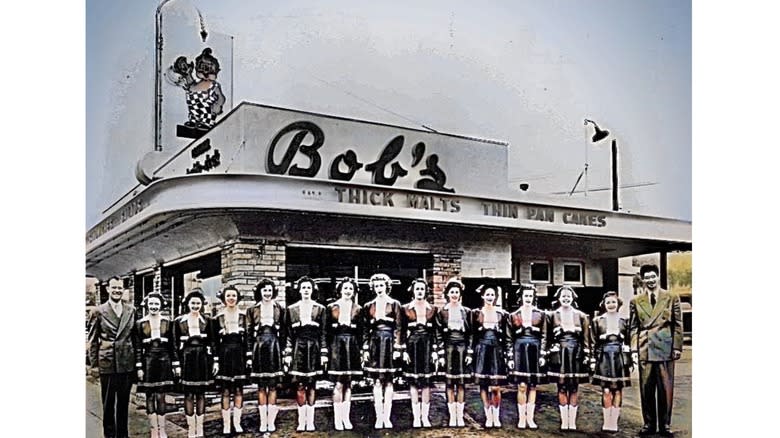
If you pulled up to Bob's in 1950, a carhop wearing a red cowboy hat would have promptly greeted you with a huge smile and placed a number under your windshield wiper. She'd take your order, then carry the food to your car on a tray that clamped onto the door. You never had to leave your car, and the service was top notch.
In the early years, carhops defined Big Boy just as much as its double-deck hamburger, but it wasn't an easy job. Wages were low, workers were in the sun all day, and some customers were aggressive. In 1947 owner Bob Wian had a hand in creating a 30-minute recruiting and training video (via YouTube). It tells the story of Eve as she interviews for a carhop position and learns about the job. Wian hires the former stenographer, and she happily accepts, saying she'll earn more money and spend time outside.
Seven years earlier, in 1940, Californian authorities had threatened to shut down any drive-in that paid less than minimum wage -- $16 a week. Restaurant owners were furious because they hadn't been paying carhops anything -- the women survived on tips alone. During a court challenge, several carhops testified they earned between $25 and $70 a day in tips. Years later, in 1978, Harry Newland, then president of the International Drive‐In Association, told The New York Times that minimum wage had been the end of the carhop.
The Oldest Remaining Bob's Big Boy Is In Burbank

It's no longer possible to eat at the first Big Boy, but you can still get close by visiting Bob's Big Boy in Burbank, California. Bob Wian tore down the original 10-seat restaurant and replaced it in 1956 with a new Googie-style, California-coffee-shop-modern building designed by architects Wayne McAllister and William C. Wagner. All we have left of that first structure are photographs from the Los Angeles Times archives and perhaps a few from the Glendale library. Sadly, the second building has also ceased to exist. In 1967, Wian sold his chain of restaurants to the Marriott Corporation and accepted a job overseeing its Big Boy restaurant division. The company eventually sold the Glendale site to developers, who leveled the site in 1990 to make way for a mall.
If you're still craving an old-timey Big Boy experience, though, head to Burbank, just about 10 minutes from the first restaurant's location. Wian founded this one as well, and McAllister also designed it. In fact, Wian built the Burbank Big Boy in 1949, so it's an early example of that futuristic space-age design popular at the time. California has determined this site a point of historical interest. These days, every Friday night, the diner hosts a classic car show. And in January 2024, staff launched a year-long celebration in honor of the diner's 75th anniversary.
[Featured image by Minnaert via Wikimedia Commons | Cropped and scaled | CC BY-SA 3.0 DEED]
The First Frisch's Big Boy Was In Cincinnati, Ohio
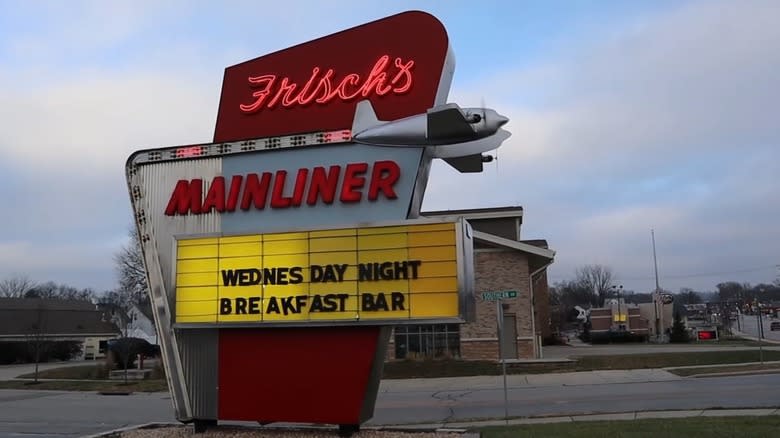
You can still visit the first Frisch's Big Boy if you're ever in Cincinnati, Ohio. Dave Frisch opened it as the Mainliner in 1939, following in his father's footsteps in the restaurant business. It was the city's first year-round drive-in. Business was brisk, and Frisch had great success.
Fascinatingly, Bob Wian and this Ohio businessman were on the same path at the same time but in completely different parts of the country. They wouldn't become friends and colleagues until 1946 when Frisch met Big Boy's owner at a food service conference in California. Frisch fell in love with the double-deck hamburger and wanted to add it to his menu. So a franchise of sorts was born. The Mainliner became the first of Frisch's Big Boy restaurants -- Frisch even personalized the signature burger by replacing the Big Boy sauce with a homemade tartar sauce -- but Frisch's company stayed independent from Bob's. This parallel Big Boy chain grew to around 200 locations in its heyday.
Today, it is the oldest Big Boy in business since it still operates in the 1939 location. The company remodeled the building in 2018 to include a museum documenting the history of Frisch's Big Boy, but the original sign for the Mainliner remains.
Read the original article on Mashed


